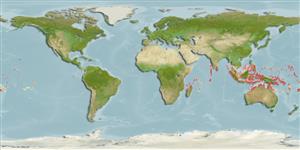>
Atheriniformes (Silversides) >
Atherinidae (Silversides) > Atherinomorinae
Etymology: Hypoatherina: Greek, hypo = under + Greek, atherina, the Greek name for the eperlane; 1770 (Ref. 45335).
More on author: Schultz.
Environment: milieu / climate zone / depth range / distribution range
Écologie
marin récifal; profondeur 0 - 5 m (Ref. 86942). Tropical; 12°N - 20°S
Indo-Pacific: East Africa to the northern Cook Islands, north to New Guinea and the Marshall Islands, south to northern Australia, New Caledonia and Fiji.
Taille / Poids / Âge
Maturity: Lm ? range ? - ? cm
Max length : 10.0 cm TL mâle / non sexé; (Ref. 48635); common length : 4.0 cm TL mâle / non sexé; (Ref. 2871)
Épines dorsales (Total): 6 - 8; Rayons mous dorsaux (Total): 8-12; Épines anales 1; Rayons mous anaux: 12 - 17. Ascending process of premaxilla long and slender; ramus of dentary highly elevated posteriorly; midlateral band wide, broadest between anus and anal fin (Ref. 9760). First dorsal fin above middle of body; second dorsal fin originates behind the beginning of the anal fin; mid-lateral scales 40-43; transverse scales 5; predorsal scales 16-19 (Ref. 2334). Midlateral band width 2.3-3.3 in body depth (Ref. 37816).
Inhabits lagoons and along shorelines of outlying islands (Ref. 3302). During daylight, schooling fish may be periodically seen to jump out of the water to avoid predators. They are also easily attracted to light. The fish are gravid at about 4-4.5 cm SL by July in the northern hemisphere. Because of their large numbers, they are probably important as forage food for larger fishes (Ref. 9760).
Life cycle and mating behavior
Maturité | Reproduction | Frai | Œufs | Fécondité | Larves
Oviparous, distinct pairing during breeding (Ref. 205).
Ivantsoff, W., 1984. Atherinidae. In W. Fischer and G. Bianchi (eds.) FAO species identification sheets for fishery purposes. Western Indian Ocean fishing area 51. Vol. 1. (Ref. 3302)
Statut dans la liste rouge de l'IUCN (Ref. 130435)
Menace pour l'homme
Harmless
Utilisations par l'homme
Pêcheries: sans intérêt
Plus d'informations
RéférencesAquacultureProfil d'aquacultureSouchesGénétiqueElectrophoresesHéritabilitéPathologiesTraitementNutrientsMass conversion
Outils
Articles particuliers
Télécharger en XML
Sources Internet
Estimates based on models
Preferred temperature (Ref.
123201): 26.8 - 29.3, mean 28.6 °C (based on 1816 cells).
Phylogenetic diversity index (Ref.
82804): PD
50 = 0.5001 [Uniqueness, from 0.5 = low to 2.0 = high].
Bayesian length-weight: a=0.00562 (0.00244 - 0.01296), b=3.11 (2.91 - 3.31), in cm total length, based on LWR estimates for this (Sub)family-body shape (Ref.
93245).
Niveau trophique (Ref.
69278): 3.3 ±0.4 se; based on size and trophs of closest relatives
Résilience (Ref.
120179): Haut, temps minimum de doublement de population inférieur à 15 mois (Preliminary K or Fecundity.).
Fishing Vulnerability (Ref.
59153): Low vulnerability (10 of 100).
Nutrients (Ref.
124155): Calcium = 127 [68, 248] mg/100g; Iron = 0.732 [0.406, 1.349] mg/100g; Protein = 19.5 [17.2, 21.8] %; Omega3 = 0.125 [0.054, 0.317] g/100g; Selenium = 16.1 [7.2, 38.6] μg/100g; VitaminA = 192 [57, 585] μg/100g; Zinc = 1.94 [1.27, 2.85] mg/100g (wet weight);
